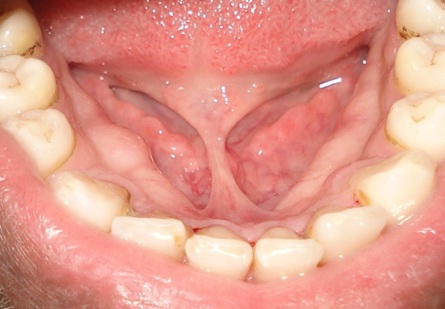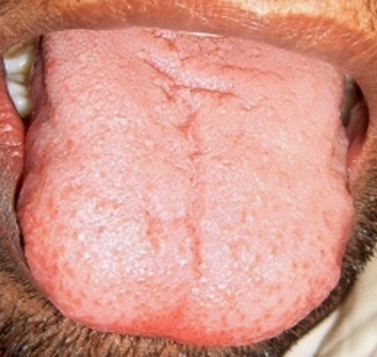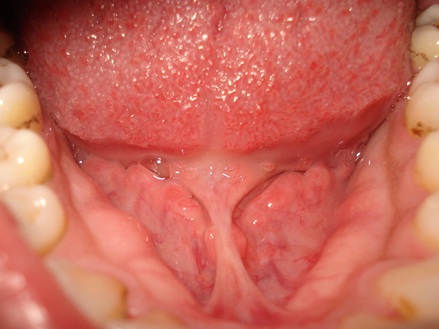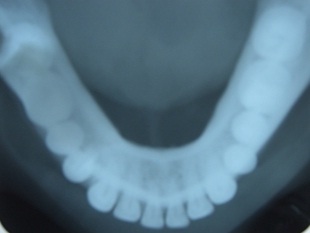A Triad of Developmental Anomalies-An Unusual Case
Rohit Sharma1, Praful Narang2, Y G Reddy3, Amit Kumar Sharma4
1 Senior Lecturer, Department of Oral Medicine & Radiology NIMS Dental College & Hospital, Jaipur, Rajasthan, India.
2 Senior Lecturer, Department of Prosthodontics, NIMS Dental College & Hospital, Jaipur, Rajasthan, India.
3 Principal, Professor and Head, Department of Orthodontics, NIMS Dental College & Hospital, Jaipur, Rajasthan, India.
4 Senior Lecturer, Department of Oral Surgery, Jaipur Dental College & Hospital, Jaipur, Rajasthan, India.
NAME, ADRESS, E-MAIL ID OF THE CORRESPONDING AUTHOR: Dr. Rohit Sharma, 13, Govardhan Colony, Behind Central Bank, New Sanghaner Road, Sodala, Jaipur, Rajasthan, India.
Phone: 09799568676, 0141-2290295
E-mail: rohitsharmasam@yahoo.co.in
Fissured tongue, Ankyloglossia, Mandibular Tori
A fissured tongue and ankyloglossia or tongue-tie is a congenital anomaly of the tongue. Mandibular tori is a proliferation of the peripheral bone that results from a localized, excessive growth of ossein [1, 2].
A 27 years old male patient reported to the Department of Oral Medicine and Radiology, NIMS Dental College, Jaipur, with the complaints of a difficulty in swallowing food and difficulty in speaking, which were there since childhood. On intra-oral examination, a high and thick lingual frenum was observed, which restricted the tongue movements and caused a inability in protruding and touching the palate [Table/Fig-1]. The dorsum of the tongue presented with a deep vertical fissure which extended till the tip and multiple connecting grooves in the transverse direction [Table/Fig-2].

Shows Vertical fissure on tongue till the tip and horizontal groves

On examining the floor of the mouth, an oval swelling was found to be present on the right and left sides below the alveolar crest, which extended from the canine and the premolar regions, with the overlying mucosa being pale as compared to the surrounding mucosa. On palpation, the swelling was found to be hard in consistency, with the overlying mucosa being firm, non-tender and fixed [Table/Fig-3]. A mandibular occlusal radiograph was taken for the swellings and it revealed bulging of the bone with a normal radiographic bone pattern [Table/Fig-4]. A clinical examination revealed the reason for the difficulty in speech as ankyloglossia. Other additional findings were the presence of a fissured tongue and lingual swellings as Mandibular tori.
Shows bilateral Mandibular Tori

Show bilateral opaque bulge of bone with normal bone pattern

Ankyloglossia or tongue-tie is a congenital anomaly in which a short, lingual frenum or a highly attached genioglossus muscle restricts the tongue movements, which has an incidence rate of 5% in the normal population. Ankyloglossia is associated with other syndromes, namely, the Pierre Robin Syndrome, the Oral-Facial-Digital Syndrome, Meckel’s syndrome, the trisomy 13 syndrome, the Robinow Syndrome, the short rib syndrome, the ATR-X Syndrome, Fraser’s Syndrome, the Wiedemann-Beckwith syndrome, van der Woude’s syndrome, and the glossopalatine ankylosis sundrome [1, 2, 3].
Fissured tongues occur in less than 10% of the normal population and they are characterized by grooves on the dorsal and lateral aspects of the tongues, that vary in depth. Fissured tongues are seen in some syndromes, namely, the Melkersson-Rosenthal syndrome, the Coffin-Lowry syndrome, Fraser’s Syndrome, Down’s syndrome, the Oral-Facial-Digital (OFD) Syndrome Type I, the Mohr Syndrome (the OFD syndrome, type II), the Pierre Robin Syndrome, the Maroteaux Lamy Syndrome, the ECC syndrome, etc. [1, 3, 4]. Mandibular tori is a proliferation of the peripheral bone, that results from a localized, excessive growth of the bone, whose incidence rate is 8% in the normal population and which is only seen in Gardner’s syndrome [1, 2].
To conclude, an unusual case of a triad of dental anomalies with ankyloglossia, fissured tongue and mandibular tori, has been presented. Although many syndromes are associated with the above mentioned findings individually, it remains unclear whether such a combination occurs by chance or whether it is a true syndrome.
[1]. Greenberg Martin S, Glick Michael, Burkit’s Oral Medicine diagnosis and treatment10th editionIndiaElsevier [Google Scholar]
[2]. Shafer William G, Hine Maynard K, Levy Barnet M, A text book of Oral Pathology 1983 4th editionW. B. Saunders Company [Google Scholar]
[3]. Gorlin Robert J, Cohen M Michael, Hennekam Raoul CM, Syndromes of head and neck 2001 4th editionOxford University Press Inc [Google Scholar]
[4]. Jones Kenneth, Smith’s Recognizable Patterns of Human Malformations 2005 6th editionSaunders [Google Scholar]